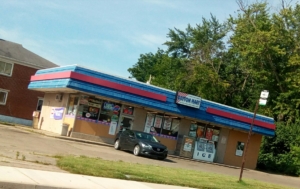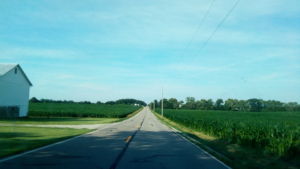How Many Ohios?

“…everything was marvelous and everything became gray and irrational and everything sparkled again, as when a cloud passes over the sun and the sun appears to flee, a timid, pale disk, near extinction, but now look, once the cloud dissolves it’s suddenly dazzling again, so bright you have to shield your eyes with your hand.” Elena Ferrante
I’d never been to Ohio when we moved to Dayton in August 2006. My husband is in academia, and this was where he’d landed a job, a great job that would pay him well and challenge him and respect him: an offer that we couldn’t refuse.
 The Midwest was unknown to me—the way sky cups the land, the uninterrupted horizon, the endless reorganization of clouds, the city blocks striated with farmland, the abandoned factories, the squatter-occupied Victorian homes, the shredded curtains waving from broken windows, the box-store pattern of suburbs fanning out toward fields of soybeans, fields of corn. We drove through Dayton for the first time on the way to the apartment my husband had rented on Craigslist. The streets were hugged by bungalows—the former homes of factory workers—that would have sold for half-a-million or more in California, and dotted with storefronts, dressed with mid-century signage that would have been kitsch on the West Coast. By the time we arrived in Dayton, most of the big factories had packed up and moved on. The once-grand department stores downtown were long-shuttered. There was no kitsch, because nostalgia is not ironic in a city that’s been left behind.
The Midwest was unknown to me—the way sky cups the land, the uninterrupted horizon, the endless reorganization of clouds, the city blocks striated with farmland, the abandoned factories, the squatter-occupied Victorian homes, the shredded curtains waving from broken windows, the box-store pattern of suburbs fanning out toward fields of soybeans, fields of corn. We drove through Dayton for the first time on the way to the apartment my husband had rented on Craigslist. The streets were hugged by bungalows—the former homes of factory workers—that would have sold for half-a-million or more in California, and dotted with storefronts, dressed with mid-century signage that would have been kitsch on the West Coast. By the time we arrived in Dayton, most of the big factories had packed up and moved on. The once-grand department stores downtown were long-shuttered. There was no kitsch, because nostalgia is not ironic in a city that’s been left behind.
* * *
Dayton, Ohio prides itself on being the “Birthplace of Aviation,” the childhood home of Orville and Wilbur Wright, a city of innovation, the US city with the most patents per capita at the turn of the twentieth century. The first airplane was designed in Dayton, as were cash registers and ATMs, and the ignition that starts your car. By the mid-twentieth century, the city and its environs, nestled in a Southeast Ohio fertile river valley, the Miami Valley, was home or second-home to burgeoning mid-century industrial giants such as General Motors, National Cash Register, and Mead Paper. The city was an expression of the post-war American dream; ranch houses, postage-stamp lawns, picket-fences. But we’ve all heard the story: industry departs, the wheels of capitalism crank and move forward. Today, to much of the country, Dayton is the rustbelt, flyover country, the kind of place that, according to the coastal imagination, birthed the rise of Donald Trump, pop-culture shorthand for a dead dream. Over the past several decades, Dayton’s population plummeted, while unemployment and poverty multiplied. The intersection of I-70 and I-75—the crossroads of the Midwest which once served the steady flow of industry—now aid Dayton in its new role as the epicenter of the national heroin epidemic. Dayton, Ohio, heroin queen, a heartbreaking crown.
* * *
I have no right to write about Dayton, no right to write about Ohio. In a part of the country where many of my friends trace their ancestry back for multiple generations, I am an outsider. As I approach the eleventh anniversary of our move, despite the fact that this is the longest I’ve ever lived anywhere, I know I will always be an outsider, a curious interloper looking in the window, trying to understand.
* * *

During the most recent residency at the Antioch University MFA program, I attended a seminar led by the writer Sarah Van Arsdale on setting and atmosphere. Van Arsdale emphasized that atmosphere is emotion, that setting in literature is imbued by the emotional context of the point-of-view inhabited by the narrator. In August 2006, I arrived in a shaky but hopeful Dayton. Newly married, I was six months pregnant with my first child, and despite being in an unknown place, I prepared to live the life I’d always dreamed of living. A home, a family. My fantasy of permanency. Everything was scary, and beautiful, and imbued with hope. I imagined that the abandoned lots and fields of Dayton could bloom into lush, permaculture gardens, the abandoned buildings could become artist colonies and settlement houses. The tide could turn. The hourglass ran out on George W., and the country was on the cusp of the Obama administration. My husband and I had a baby, bought a house, adopted a kitten, had another baby. We made new friends. My husband loved his job, I started a successful business. Barack Obama won Ohio—twice, three times if you count the primary! My husband and I, with our babies, campaigned for Obama in white, working class neighborhoods, knocking on doors and handing out flyers. No one seemed to blink at our multi-racial family. They took our flyers, wished us a good day. The sun was shining. Change and hope, hope and change. It was a beautiful, beautiful Ohio.
* * *
While many white liberals, myself included, basked in the post-racial myth of the Obama administration, in Ohio, as elsewhere in the United States, unarmed black men and boys continue to die at the hands of law enforcement. Dayton is not exempt from this tragedy. On August 5, 2014, while I finished up paperwork in my office, John Crawford III, a loving father of two children, was murdered while shopping in a Walmart in the predominantly white Dayton suburb of Beavercreek, less than ten miles away. In this particular incident of state-sanctioned murder, Crawford was killed after a fellow shopper, a young white man, called 911 and lied to the operator, informing her that Crawford was pointing a gun at people, when in fact, he was loosely carrying an air rifle—merchandise he had picked up in the store—while talking on his cell phone. John Crawford’s back was turned to the officer who shot him. No criminal charges were brought against that officer, Sean Williams, of the Beavercreek Police Department.
Although a steady group of protesters, organized largely by Black Lives Matter Miami Valley, showed up at events at the Walmart, the nearby mall, the county courthouse, and elsewhere, traffic never stopped flowing down the suburban streets, and life went on as usual. At one of the larger protests, white shoppers continued to shop, blithely stepping over protesters who lay on the glistening floor of the mall, while red-faced security guards screamed inches away, and police loaded protesters into vans. This image, of white people stepping over the bodies of protesters in the name of consumerism, is emblematic of the apathy and denial that chokes progress. Nevermind justice, the shopping must go on.
There has been no justice for John Crawford or his family. Apathy is implicated here, as is the Obama era version of hope which turns out to be a pretty mask on the face of denial. White Ohioans, myself included, shoulder the responsibility of breaking down apathy and denial, these diseases of the white soul that devastate communities of color, in Ohio, and across the country. The road ahead is long, and necessary.
This is a terrible, terrible Ohio.
* * *
That which was festering erupted. On Election Day, 2016, after repeatedly yelling at the television, “Come on, Ohio! Come ON, Ohio!” I went to bed before the state results were called. My husband stayed up. He looked grim. He let me sleep through it. Seven more hours of a fantasy. In the middle of the night, the sound of horns blaring and loud male voices cheering careened through the streets of my town. I put my pillow over my head to muffle the sound. The next morning we took the children for a walk before we all went our separate ways for work and school. The sky was gray, a heavy cloud cover hanging over us. The streets were almost empty. We passed a woman clutching her coat around her body. She was crying. Friends of ours had campaigned for Hillary Clinton in the same white, working class neighborhoods where my family had knocked on doors four years ago. They told us they’d been chased out. They’d been threatened with dogs.
* * *
My husband, who is Asian-American, took the children to a restaurant in Beavercreek. He noticed that everyone else in the room was white. He told himself he would be fine.
* * *

There are Confederate flags in windows and on bumper stickers. There are billboards, and Trump signs and placards with monstrous Hillaries that say “lock her up” and banners the size of small houses.
In the era of Trump, how much has my new home changed? How much has white, middle-class privilege blinded me? The statistics point to the possibility that many of the same people who voted for Obama voted for Trump. How do I get my head around Ohio?
And since Ohio election results typically point to the winner of the national election, perhaps what I’m really asking is, how do I get my head around this country?
Time has not stopped. Since the election, pockets of protest and resistance grow, even in sleepy Dayton. Ironically, the most recent census has revealed that Dayton’s population is stabilizing, thanks to growing immigrant and refugee communities. (Take that, Trump.)
It’s not easy to hope. But to give up hope is worse, a paralysis as toxic as denial. At the end of hope, that’s where time stops. My children were born here. They love Ohio; this is their home. To do right, I have to dig in, to learn how to grow within an imperfect place, a place that, bit by bit, I belong to. And to belong, I take responsibility. What’s wrong with Ohio is what’s wrong with this country. What’s wrong with this country, is what’s wrong with me.

I want people in other parts of the country to imagine what life is like here. I want people on the coasts to feel how we are connected, how abandonment and denial in the rustbelt are connected to gentrification and denial in the more prosperous coastal cities.
It is a beautiful Ohio. It is a terrible Ohio. How many, how many Ohios?

Melissa Benton Barker lives in Ohio with her family. She is an MFA candidate at Antioch University Los Angeles and currently serves as the Managing Editor for Lunch Ticket. Her work can be found on Smokelong Quarterly, Gravel, and Literary Mama.





